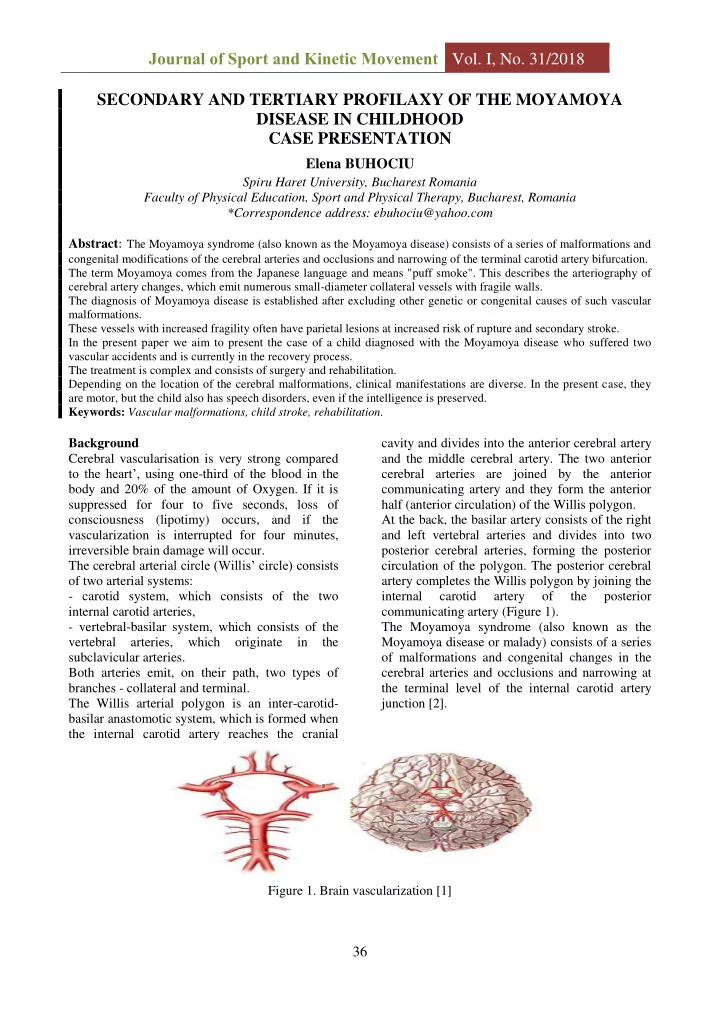

Journal of Sport and Kinetic Movement Vol. I, No. 31/2018 SECONDARY AND TERTIARY PROFILAXY OF THE MOYAMOYA DISEASE IN CHILDHOOD CASE PRESENTATION Elena BUHOCIU Spiru Haret University, Bucharest Romania Faculty of Physical Education, Sport and Physical Therapy, Bucharest, Romania *Correspondence address: ebuhociu@yahoo.com Abstract : The Moyamoya syndrome (also known as the Moyamoya disease) consists of a series of malformations and congenital modifications of the cerebral arteries and occlusions and narrowing of the terminal carotid artery bifurcation. The term Moyamoya comes from the Japanese language and means "puff smoke". This describes the arteriography of cerebral artery changes, which emit numerous small-diameter collateral vessels with fragile walls. The diagnosis of Moyamoya disease is established after excluding other genetic or congenital causes of such vascular malformations. These vessels with increased fragility often have parietal lesions at increased risk of rupture and secondary stroke. In the present paper we aim to present the case of a child diagnosed with the Moyamoya disease who suffered two vascular accidents and is currently in the recovery process. The treatment is complex and consists of surgery and rehabilitation. Depending on the location of the cerebral malformations, clinical manifestations are diverse. In the present case, they are motor, but the child also has speech disorders, even if the intelligence is preserved. Keywords: Vascular malformations, child stroke, rehabilitation. Background cavity and divides into the anterior cerebral artery Cerebral vascularisation is very strong compared and the middle cerebral artery. The two anterior to the heart’, using one -third of the blood in the cerebral arteries are joined by the anterior body and 20% of the amount of Oxygen. If it is communicating artery and they form the anterior suppressed for four to five seconds, loss of half (anterior circulation) of the Willis polygon. consciousness (lipotimy) occurs, and if the At the back, the basilar artery consists of the right vascularization is interrupted for four minutes, and left vertebral arteries and divides into two irreversible brain damage will occur. posterior cerebral arteries, forming the posterior The cerebral arteria l circle (Willis’ circle) consists circulation of the polygon. The posterior cerebral of two arterial systems: artery completes the Willis polygon by joining the - carotid system, which consists of the two internal carotid artery of the posterior internal carotid arteries, communicating artery (Figure 1). - vertebral-basilar system, which consists of the The Moyamoya syndrome (also known as the vertebral arteries, which originate in the Moyamoya disease or malady) consists of a series subclavicular arteries. of malformations and congenital changes in the Both arteries emit, on their path, two types of cerebral arteries and occlusions and narrowing at branches - collateral and terminal. the terminal level of the internal carotid artery The Willis arterial polygon is an inter-carotid- junction [2]. basilar anastomotic system, which is formed when the internal carotid artery reaches the cranial Figure 1. Brain vascularization [1] 36
Journal of Sport and Kinetic Movement Vol. I, No. 31/2018 Occlusions are mostly bilateral and are localized The term Moyamoya comes from the Japanese on the arteries that form the Willis arterial language and means "smoke cloud". This polygon [3] at the base of the brain, resulting in describes the arteriography of cerebral artery the development of a neo-vascular arteriole and changes, which emit numerous small-diameter capillary network with increased fragility. These collateral vessels with fragile walls. According to vessels with increased fragility often have parietal prof. Burunsus (State University of Medicine and Pharma cy “Nicolae Testemiţanu” - Chişinău), the lesions at increased risk of rupture and secondary stroke. The diagnosis of Moyamoya disease is term would refer to "a thin fog-like appearance, a established after excluding other genetic or fine, fluffy image that is given by the basal congenital causes of such vascular malformations. anastomotic vascular network" [4] (Figure 2). Figure 2. Angiographic image - Moyamoya syndrome [5, 6] The disease is also known as the juvenile varying degrees of stenosis or occlusion, this occlusive disease of the Willis polygon, cerebral being associated with thickening of the tunica brain jungle brain telangiectasia, or chronic intima , thinning of the tunica media and the cerebral occlusive vasculopathy [5], but in our fragmentation of the elastic membrane. Once the opinion none of them fully express the artery occlusion begins, it is progressive, in some etiopathogenic aspects and manifestations of the people it can cause repeated vascular cerebral disease. On the other hand, the condition is not attacks that lead to severe functional sequelae, or within the group of cerebral vasculitis [6]. even death, and in some there may be no The reported incidence of the disease in the USA symptoms. The Moyamoya disease initially is of 0.086 per 100,000 people [7]. It was first causes constrictions in the internal carotid artery, described in 1957 in Japan as hypoplasia of but often the anterior and middle artery can be internal carotid arteries. In this country, the affected. incidence is about 4 cases per 100,000 people. The Moyamoya-specific arterial constriction is Both European countries, as well as other different from the one caused by arteriosclerosis. countries of the Far East and the American In arteriosclerosis, the walls of the arteries are continent, have been reported. An incidence of damaged, leading to cell deposition, while in 0.35 per 100,000 people is reported in Europe. Moyamoya, the internal layer of the carotid artery The disorder may be unilateral or bilateral and proliferates inside the arterial lumen. Within the may occur at any age [8]. artery, blood clots are also formed. Anatomopatologically, it is described as the The abnormal vascular network develops tunica indima ’s thickening in the terminal parts of especially in the carotid apexes, consisting of the internal carotid vessels at bilateral level. small and thin vessels along the affected area. Proliferation of the intima may also contain lipid This network, being very fragile, is exposed to the deposits. The anterior, middle and posterior risk of arterial rupture (Figure 3). arteries that form the Willis polygon may exhibit 37
Recommend
More recommend